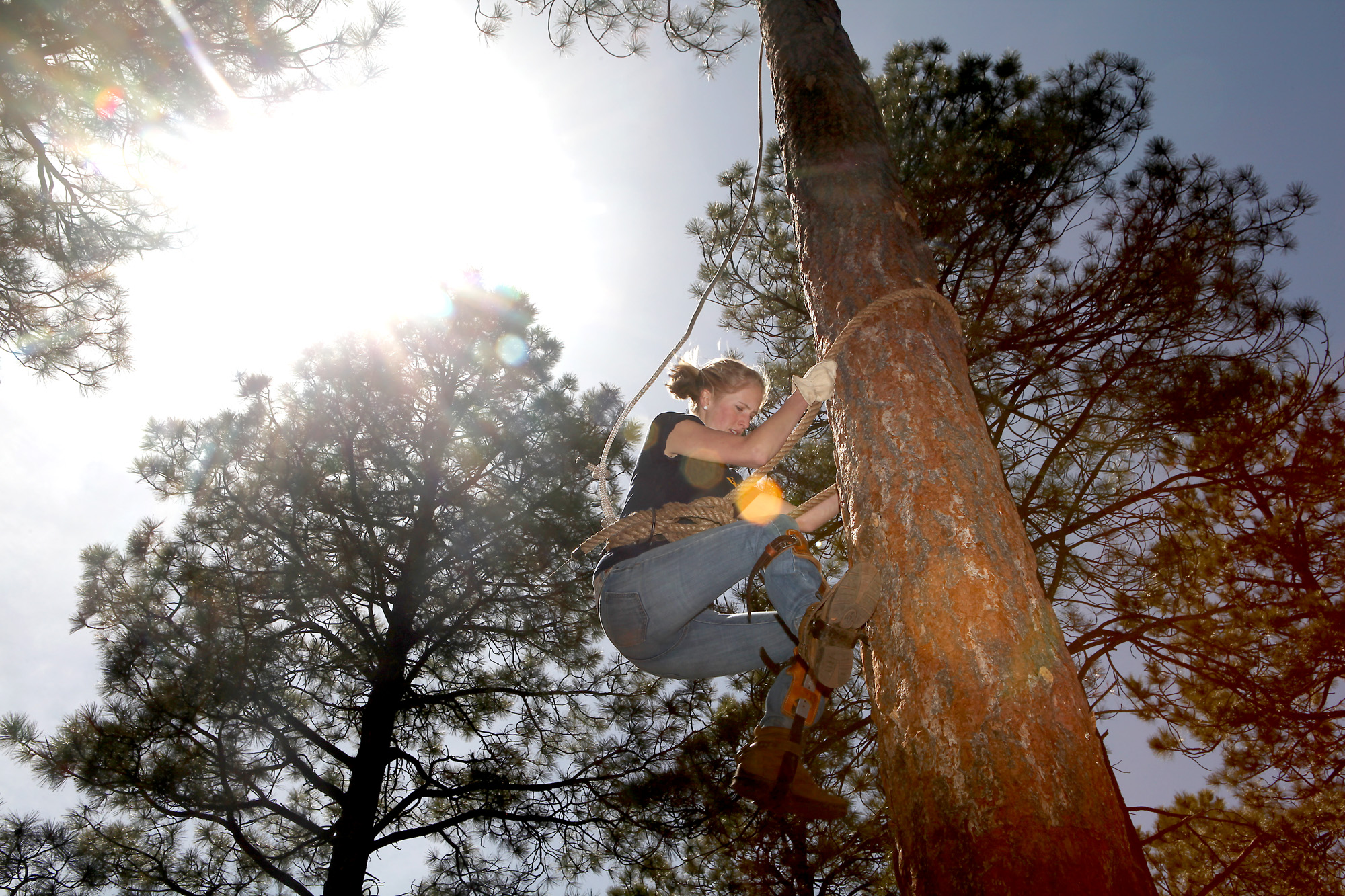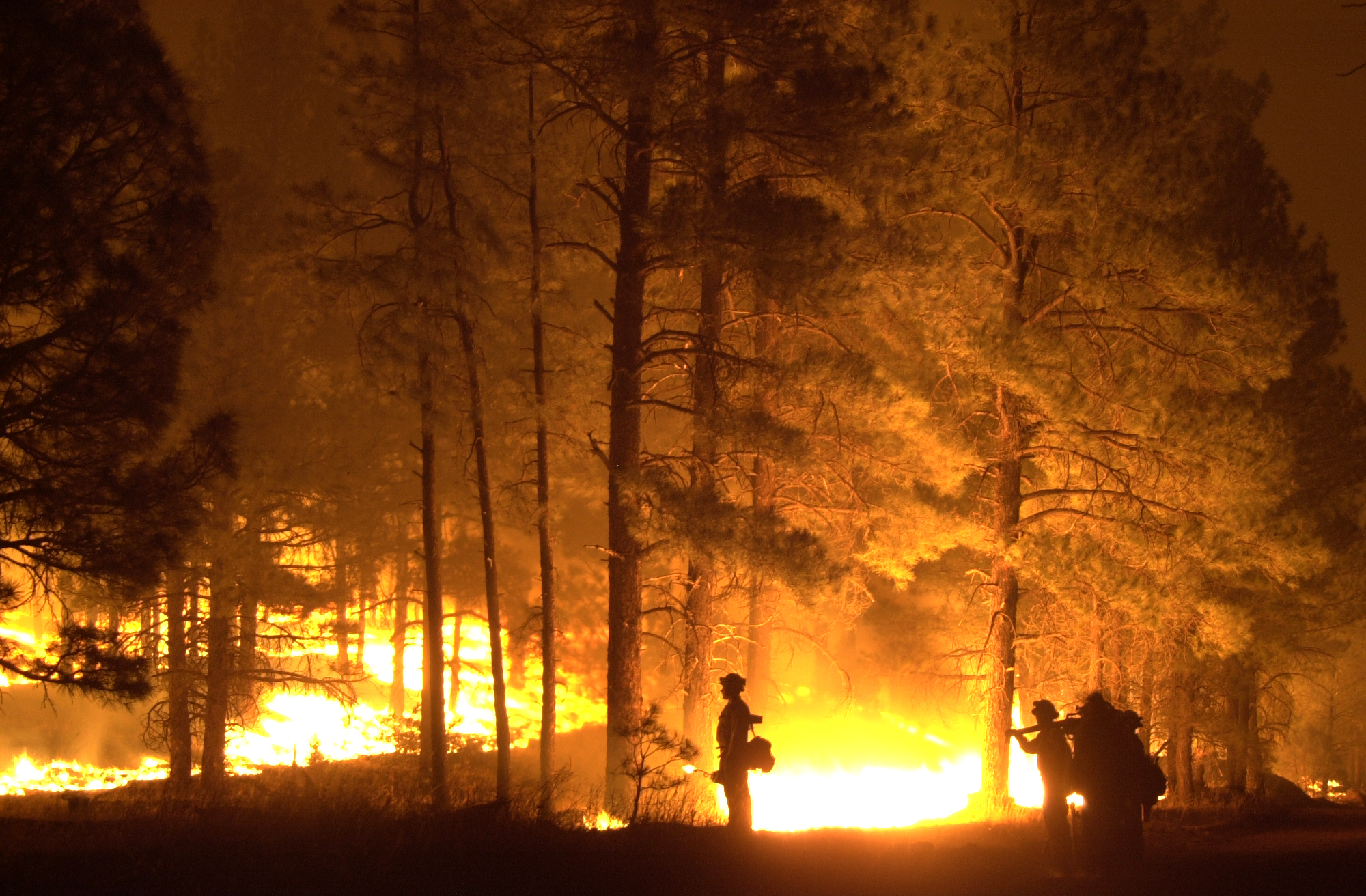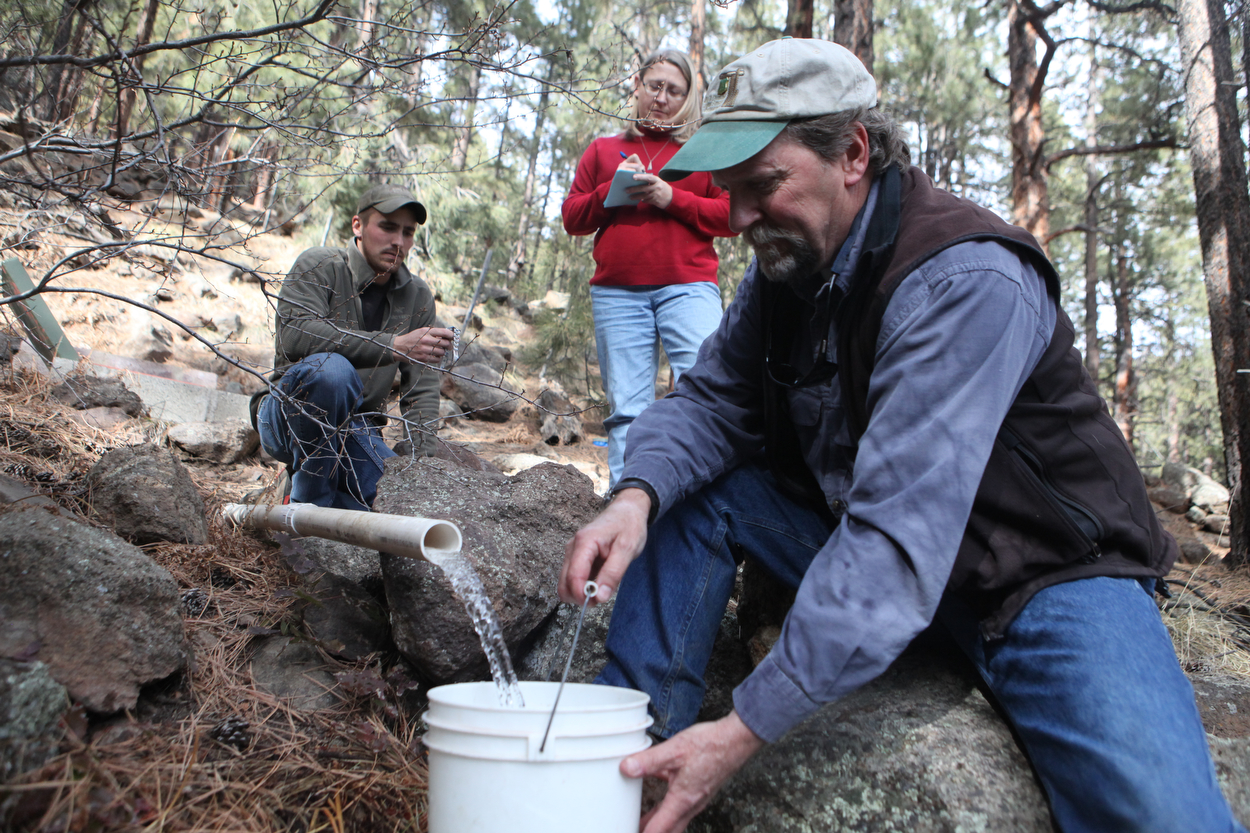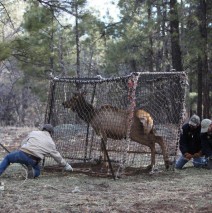The Lumber Games
With heart pounding, the teenager struggled to keep her focus on the task at hand, digging her spurs into the skinned tree, reaching the flip line higher around the trunk and pulling herself farther from the safety of the ground as fast as she could in the driving rain. Having watched her competitors drop to their fate under the slippery, strenuous conditions, Katriana Joyce tried not to be distracted as she stretched for the red finish line that marked the end of the race, 30-feet up in the air. Elsewhere in the forest, another young competitor, Casey Branning, was hoisting a heavy, double-bladed axe as far as he could over his head, using all his might to thrust the razor-sharp weapon at his target. These may sound like the life or death challenges in the popular movie, "The Hunger Games," but forestry students have been competing this way for decades. And while "The Hunger Games" may be generating a renewed interest in ancient outdoor sports, Northern Arizona University's School of Forestry students have been practicing these skills in the woods year-round. STRENGTH, AGILITY AND SPEED Joyce, Branning and 14 of their classmates on the NAU Forestry Club Logging Sports Team recently competed against 15 other schools, totaling 187 competitors, in the 73rd Annual Conclave of the Association of Western Forestry Clubs in Corvallis, Ore. The Lumberjacks finished seventh overall. For Joyce, the 45 seconds it took to climb the tree was not fast enough to place in the games. The winner did it in 15. As for those who fell, safety ropes kept them from hurting anything except their chances to win. Like "The Hunger Games," logging sports involve strength, agility, speed and the talent to master seriously sharp tools. But with safety gear in place, the most dire consequence might be falling into 38-degree water. Such is the case in an event known as birling. NAU Logging Sports Team Captain David Gouveia, a stocky 5-foot-8, 200-pound forestry junior from Tucson, has been practicing in icy Lake Mary. Birling involves two competitors standing on a log in a lake. Each struggles to stay upright as it rolls. "It's a very tough event. Not a lot of people can manage to stay up on a spinning log," he said. "It takes strong legs and balance." "It's impossible not to get wet," said teammate Tor Skeen, a junior from southern California. "You're trying to put the other person off balance by changing the direction of the rolling log." For Gouveia, the practice paid off. He placed third in birling at the Conclave. POWER TOOLS, TOO He also took fifth place in the double buck contest with teammate Thomas Roland from Fort Collins, Colo., a forestry sophomore. The double buck involves the two-handled peg and raker crosscut saw, a tool once commonly used by lumberjacks to fell large trees and still used in wilderness areas where motorized equipment is not allowed. "You're sawing together to cut a disc off the end of a 15-inch diameter log and you're doing it as fast as you can," Gouveia said. Gouveia also competed as NAU's representative in the STIHL Timbersports Series, a competition sponsored by the power tool manufacturer in association with the Logging Sports. It involves four events: the single buck using a crosscut saw; the standing block chop; the horizontal or underhand block chop; and the stock saw. "Bucking a log means cutting it into sections so you can move the wood around easier," said NAU Forestry Club freshman Mike Mishler of Tucson. "On the horizontal block chop you're standing on a 26-inch...
Read MoreAn Era of Mega Fires
Helplessness. That was the feeling firefighters like Paul Summerfelt remember at the start of the record-setting fire. "You could just watch the cloud of smoke on the horizon," Summerfelt said. "You knew it was coming and you knew it was bigger than you were going to be able to deal with." Apache-Sitgreaves National Forests Supervisor Jim Zornes remembers seeing smoke from 30 miles away. "We knew we had a tiger by the tail but we didn't know how big it was," Zornes said. "I just almost fainted when we realized the potential for the fire. I thought, 'surely not!'" Both men are talking about two different half-million acre fires that have occurred in Arizona's White Mountains during the last decade. Summerfelt is recalling the 2002 Rodeo-Chediski Fire and Zornes, the 2011 Wallow Fire. Forest ecologist and Regents' Professor Wally Covington, Ph.D., says we've entered an era of mega fires. "Mega fires are huge, landscape-scale fires in excess of 100-thousand acres," said Covington, executive director of the Ecological Restoration Institute (ERI) at Northern Arizona University. "We're seeing this throughout the West, but Arizona is on the leading edge." Covington says mega fires are symptoms of an unhealthy forest caused by a century of actions -- mostly fire suppression, and overgrazing during the late 1800s -- that have changed the structure and function of ponderosa pine and dry mixed conifer forests. "We need to stop being surprised by the types of fires we're having," said Summerfelt, wildland fire management officer for the city of Flagstaff. "My first fire was on the North Kaibab and it was considered huge. It was 20 acres. A 20-acre fire now means nothing. So in those three-and-a-half decades in my career, I've been able to watch fire change in size and intensity to levels today that even a decade ago would have been unthinkable. And we're not done breaking records." Covington says Arizona is set up for three more enormous crown fires across the Mogollon Rim that burn through the tops of old growth trees and can ignite spot fires as far as 3 miles ahead of the blaze. "There's the Payson to Winslow corridor, the Sedona to Flagstaff corridor and the Prescott corridor. If we don't get out in front of these and do restoration treatments, it's just going to be a matter of time before we have three more major landscapes burn up." As we approach the 10th anniversary of the Rodeo-Chediski Fire, scientists, firefighters and natural resource managers are examining today's forest conditions and reviewing lessons learned from the state's two largest fires. To compare, both fires were started by people on warm, dry, windy days. "With the Wallow Fire, we knew we were in extreme conditions. We had fuel everywhere and our probability of ignition for any fire that hit the ground was 100 percent. With 62 mph wind gusts, it was blowing so hard it was tough to walk," said Zornes. Former Forest Service ranger and firefighter Jim Paxon, now Arizona Game and Fish Department spokesperson, describes the 468,000-acre Rodeo-Chediski Fire as a plume-dominated fire. "It was pretty much fuels related, fed by the millions of excess trees in our overcrowded forests. It had extremely high energy. When I started fighting fire in the late'60s we didn't have these big columns of plumes that would build up, collapse in an explosion on the ground and create hurricane winds. This didn't happen until the '90s." As a result, 49 percent of the area in the Rodeo-Chediski Fire was considered severely burned. For the 538,000-acre Wallow Fire, that figure is 28 percent. "It...
Read MoreLost Springs on Rebound
As patchy snow crunches under his boots and icy crystals sparkle in the early winter sun, Steve Monroe hikes to a small canyon on the southwestern side of the San Francisco Peaks. This place of basalt boulders and towering pines looks like a lot of other frozen scenes in northern Arizona's high country on a January day, except a closer look into concrete enclosures reveals movement. Water -- now released only through a system of valves and pipes. Perched into the slope is Big Leroux Spring. Its perennial flow was once an important water source for American Indians, pioneers, wildlife and Flagstaff's founders. Explorers coming through with thirsty mules and horses called it a fountain that bursts out of the side of the mountain. In 1851, Lieutenant Edward Beale described it as "transparent sparkling water" that "runs gurgling down for a quarter of a mile, where it loses itself in the valley." For the last decade, Monroe, a National Park Service hydro-ecologist, has been measuring the water flow and studying the history of the area. He says early visitors likely found the now endangered northern leopard frog here, probably salamanders, snails and dragonflies, too. "Those species have been observed at other non-diverted or less-diverted springs in this region and it's very probable that they existed at Big Leroux Spring because of the availability of water." MOST SPRINGS AT RISK But things have changed in the last century and a half. The water has been diverted for people and livestock. The wetland, created by the spring, doesn't exist anymore. Northern Arizona University School of Earth Sciences and Environmental Sustainability hydrogeologist Abe Springer says the same thing has happened all over the West. "More than a thousand springs and spring-fed wetlands support rich plant and animal life in northern Arizona, including rare species," he said. "Unfortunately almost all of them have been declared 'at risk' by the Arizona Water Institute." NAU School of Forestry Executive Director Jim Allen agrees. "Settlers would have come upon many spring-fed wetlands, such as wet meadows, here in northern Arizona that hold onto the water and slowly release it downstream," Allen said. "Today we often see deeply eroded stream channels that quickly whisk water away." TREES CHOKE OFF SPRINGS Big Leroux Spring starts from snowmelt at higher elevations. The water is absorbed by porous volcanic rock. It finds its way down the mountain through tiny tunnels and cracks. Currently, the spring water is pumped to the Forest Service Hot Shot camp at the base of the Peaks. But firefighters aren't there all year, and when they are, they're only using a small percentage of that water. Monroe says a modest flow for Big Leroux is 10 gallons per minute. That's more than a garden hose at full blast. "Many springs were plumbed decades ago to deliver drinking water to livestock, but this infrastructure is often dilapidated and can neither effectively provide water to livestock nor water for the riparian or wet meadow environments that springs would naturally support," said Sharon Masek Lopez, a watershed restoration research specialist with the Ecological Restoration Institute. In addition, millions of small-diameter trees choking Arizona's forests because fire has been excluded for many years are absorbing water and drying out meadows that historically were spongy, muddy and wet. "Trees use a greater amount of soil moisture than grasses and may be keeping springs from flowing," said Springer. RESCUE 50 SPRINGS Because springs are hotbeds for biodiversity, Springer and Masek Lopez are in search of sites like Big Leroux as candidates for restoration. Prioritizing these sites is a significant component of large...
Read MoreRanching, Reading and Writing
From establishing the institution, elevating it to university status, creating a world-renowned forestry school and Ecological Restoration Institute, advancing research opportunities and maintaining the vision of a premier undergraduate residential experience, the Babbitt family and Northern Arizona University have built a world-class commitment to stewardship of Arizona’s landscapes and communities. “The single most important thing that happened in the history of NAU regarding the Babbitt family was (the late) John Babbitt’s determination to bring the school to a university level,” said former Arizona Regent Norm Sharber. “Without the word ‘university’ on your name, it was difficult to obtain certain grants or attract top faculty. John fought some heavy battles in the legislature.” The quiet, reserved state senator served in the Arizona Legislature from 1945 to 1948 and has been recognized for his ability to make things happen. But the Babbitt family’s impact on NAU and education began long before that. In the late 19th century, the Arizona Territory was a rough place. The Arizona Territorial Legislature decided a reform school was needed to house and rehabilitate lawbreakers. George Babbitt, a gregarious, generous and popular businessman, was appointed president of the board looking into such a facility. “George probably knew a reform school was not what Flagstaff wanted, but moved forward to establish the building with the idea that the legislators’ minds could be changed about what kind of school would actually be created,” said James E. Babbitt, nephew of the late state senator with the same name. Indeed, the reform school did not materialize but the Northern Arizona Normal School did. It was a college to teach teachers. It started in 1899 with the red sandstone building now known as Old Main and later became the Arizona State Teachers College at Flagstaff. George and other leaders of the day likely believed the business of education would have a positive impact on the economy as well as on the culture of the town they were creating. GOOD FOR BUSINESS, TOO George died in 1920, but other Babbitts then championed the cause of higher education. As a state senator, James E. “Jim” Babbitt was considered one of the most influential democrats in the county. In 1936 he helped establish master’s degrees at the colleges in Flagstaff and Tempe (now Arizona State University). This move boosted enrollment in Flagstaff as credential-seeking teachers spent their summers on the mountain campus. In 1944, Jim died during a hunting trip. John was called to finish the Senate term. He was elected to another term and became Senate President. From the Senate, he went on to spend 16 years on the Arizona Board of Regents. “John Babbitt was one of the forces getting Coconino County behind the Tempe college becoming a university. He thought if we were supportive of them, they would be supportive of us. And it worked out,” said 12th NAU President Gene Hughes. “I just know that behind the scenes was John Babbitt thinking, ‘This is going to be good for Flagstaff.’ He had that vision, for the Babbitt businesses, the livestock industry and the community. John also led the effort that created the School of Forestry in 1958. SERVICE AS REGENTS Two other Babbitt family members served as regents guiding the state universities in what became known as The Babbitt Chair. Norm Sharber, a respected businessman married to Dr. Rayma Sharber (daughter of arts patron Viola and Babbitt Ranches President Joseph Babbitt) was appointed in 1965. He and NAU’s 11th President J. Lawrence Walkup would walk the campus together wondering how to accommodate the thousands of students headed their way. Those conversations...
Read MoreNorthern Arizona Elk Getting The Collar
Elk are roaming around the woods with collars around their necks. In the forest near Flagstaff, elk are being outfitted to tell researchers what they and other animals need to navigate through urban sprawl, climate change and large restoration projects. For Arizona Game and Fish Department wildlife biologist Jeff Gagnon, the job of collaring an elk is somewhat like a rodeo event. Within minutes, he and a team of wildlife managers can calm a frightened animal that might weigh as much as a thousand pounds. "We fit the collar to make sure the animal has some space and isn't being choked," he says. The collar is programmed to fall off in a few months. But in the meantime, every two hours a GPS unit is sending signals to satellites that are sending signals to biologists. Gagnon has been tracking some 130 elk around major highways, including interstates 17 and 40. "We know where the animals are, what kind of habitat they are using and what barriers are stopping them. For a lot of animals when we fragment their habitat, they can't get to resources like summer or winter range. We also run the risk of isolating or breaking up the herd, which can lead to a smaller gene pool and a weaker species." Researchers like Northern Arizona University's Paul Beier, a conservation biology and wildlife ecology professor in the School of Forestry, says this information is critically important to keep animals from stepping into danger or even extinction. "With climate change, we have the situation where habitat is literally moving out from under the feet of wildlife," he says. "In order for these species to stay where they are, in terms of a healthy population, they have to move." Beier is developing maps detailing links for wild areas, or wildlife corridors, to help land managers understand how animals move across the land. "We're creating landscapes that are more permeable than the landscapes we had a decade or two decades ago," he says. "If you provide habitat for the large species, you bring the others along," says Arizona Game and Fish Department Habitat Program Manager Sarah Reif. "Elk, mule deer, pronghorn antelope -- these are the big guys we manage for because of public safety on highways and roads, and because they have the biggest home ranges." Pronghorn have long been a symbol of the West, but researchers say barriers like canals, fences and highways have had a substantial impact on the population. "In Arizona, the numbers declined from about 45,000 animals in the early 1900s to roughly 7,500 in 2002," says Reif. "Since then, we have recovered the population to somewhere around 11,000 but we still have a lot of work to do to connect pronghorn habitats." With information about wildlife movement, highways are becoming less of a hindrance, and safer for wildlife and people. Groups like the Arizona Department of Transportation, Elk Society, Rocky Mountain Elk Foundation and Federal Highway Administration are funding research and passageways. For example, along State Route 260 near Payson, highway improvement projects have included wildlife elevated crossings. "Animals are using the crossings," says Gagnon, "and collisions between elk and motorists have been reduced by at least 85 percent." Wally Covington, executive director of the Ecological Restoration Institute at NAU, says managing for wildlife corridors is increasingly important as forests are restored on a landscape scale. "Across hundreds of thousands of acres, natural habitat can be restored. Wildlife can self-regulate. Predator-prey dynamics can keep populations in a sustainable, steady state that's characteristic of the evolutionary environment." Wearing high-tech necklaces, today's elk may well be...
Read More




